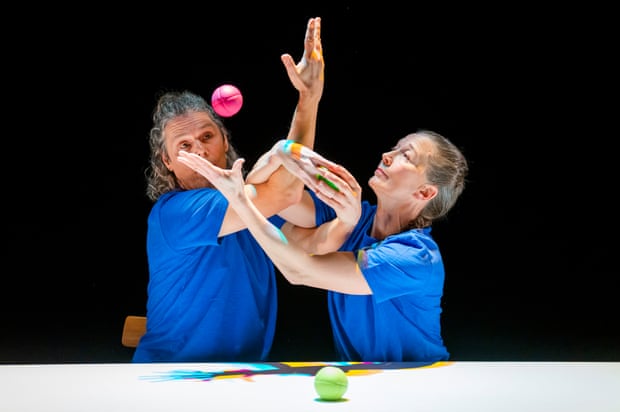Review from: The Place, London International Mime Festival; 20th January 2023
The celebration of Gandini Juggling’s 30th anniversary of making entertaining, artistic, and technically exciting juggling performances is marked by this new show, The Games We Play, co-commissioned by the London International Mime Festival. The joy of this celebration is tempered slightly by the fact that the Mime Festival itself is closing after 47 years of surprising and endearing visual and physical theatre programming. This does not, however, detract in anyway from the joy of juggling that emanates from every pore of the new show.
As a retrospective, the performance works brilliantly for fans of the Gandinis’ work. We get everything they’re so good at, packaged up in the colourful and insightful montage that they do so well. Sean Gandini is charismatic and relentlessly chatty. Kati Ylä-Hokkala – Sean’s wife and company co-founder – is amusingly stoic as his long-suffering foil*. Together, they give us their trademarks of vocal patterning, rhythmic words, recorded sounds, gestural choreographies, lushious lighting states (Guy Hoare is a long-time collaborator) and philosophy, along with the throwing, catching and passing of balls that are more commonly associated with the term juggling.
Glimpses of past works blend in and out of the presentation, in tones of music, styles of dance, in choreographies of limbs and of their tossed and bounced and rolled companions. The online freesheet programme notes – which the Mime Festival offer instead of less sustainable paper versions – mentions specific extracts included from early collaborative works, but I also notice glimpses of Sigma‘s flowing arm symmetries, the balletic extensions of 4×4 Ephemeral Architectures, and some eye-openingly simple juggling motifs that remind me of sequences in Akhnaten and Smashed. The spoken elements of the show also refer more overtly to previous work and the artistic practices that the company has developed over their 30 years.
Analogies are drawn between the appreciation of static art works and juggling patterns in terms of shapes and colour, and contrasted with the more conventional numerical approach of juggling notation. The show feels excellently pitched for both the juggling ‘cogniscenti’ and newcomers to the form, drawing humour from the complexity and density of the more technical elements that might otherwise feel alienating. Amongst other things, I learn about ‘tappeties‘ – a method of complicating pre-existing juggling patterns – and ‘passive and active 2s’ – a way of conceptualising how hands and balls interact. I also find myself laughing out loud again and again, and am not alone in this.
And, as much as the show has a lecture presentation element, it also injects sections of storytelling. Fascinating snippets from historical performers and performances are introduced, hinting subtly at the retrospective theme and nostalgia for past glories. Amongst other things, I learn about Lola the performing pig, and the Oklahoma Tunnel Shuffle, and am trying to resist the urge to google the stories to find out whether they are fact or fiction (although, in truth, fact is often the strangest). I get a sense that the company have raided all their journals from the past three decades to pull out interesting tidbits they once jotted down, threading them all together for us now.
The Games We Play is full. A celebration of past innovations, rather than an innovation in itself, and a well-deserved pat on the back. Look what you did guys! Just look what you did! A faint underlying celebration of Sean and Kati’s own relationship also runs through the show. As they find ways to intersect juggling into classic choreographic moments of tango and waltz, we see the tender holds of a longterm married couple. We get to see inside their studio reality as they share their frustrations with their practice and their partnership behind the surface performance presentation. They illustrate again and again their sharing and mutual respect as they split patterns between them, offering insight into their process and their lives together.
The show even manages to inject a touch of drama that draws sentimental tears to the corner of my eyes. Perhaps, after all, this is their innovation here?
Ultimately, TLDR: Everything a retrospective should be. ❤️
*Although to a stranger this might appear to be a classically imbalanced gender relationship – and, indeed, I overhear someone commenting on this as I leave – to those familiar with the pair’s work it feels like balance of a different kind, based on individual character and preference rather than blanket role-sharing.


